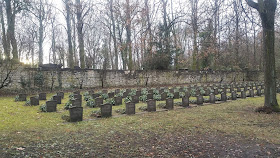 |
| Berlin, Germany. Weissensee Jewish Cemetery. Field of Honor Monument, 1926. Photo: Samuel D. Gruber 2016 |
 | |
| Berlin, Germany. Weissensee Jewish Cemetery. Wreaths laid at Field of Honor Monument, 1926. Photo: Samuel D. Gruber November, 2016 |
Germany: Berlin's Field of Honor for Jewish Soldiers Killed in World War I
by Samuel D. Gruber
I've written a few times (2009, 2012) about war monuments for Jewish War dead, especially the many monuments and memorials erected across Europe after World War I, when Jewish soldiers fought in the armies of all the combatant nations. Germany had the most soldiers - approximately 100,000 - and probably did the most the memorialize the fallen in the decade after the war. For more on memory and denial of German-Jewish war service see Tim Grady's recent book The German-Jewish Soldiers of the First World War in History and Memory (Liverpool: Liverpool University Press, 2013).
I'm not aware of any compendium of images and information on all the monuments erected in cemeteries and synagogues across Germany, but Jews in the 1930s used these (unsuccessfully) to make the case of their German patriotism in the face of growing Nazi oppression. At the time, perhaps the best known and probably the largest of these was the Field of Honor created for the war dead at Berlin's Jewish Cemetery at Weissensee, the large burial ground opened in 1880 in the northeastern part of the city. Designed by Community architect Alexander Beer (who would later die in the Terezin Concentration Camp), the Field and its 394 graves are very well maintained, even though much of the adjacent cemetery area is still being tamed after decades of neglect. The war cemetery was situated right behind the new Hall of
Mourning. This structure was destroyed by bombs in the Second World War. Its ruins now a grassy mound.
 |
| Berlin, Germany. Weissensee Jewish Cemetery. Field of Honor Wall. Photo: Samuel D. Gruber 2016 |
 |
| Berlin, Germany. Weissensee Jewish Cemetery. Field of Honor Wall. Photo: Samuel D. Gruber 2016 |
The so-called Heroes Cemetery, where Jewish dead of the great war are buried, is here a cemetery within a cemetery. The rows of graves are arranged with military precision, all alike, a touching answer to the anti-Semitic charges levelled against us in this present period of German life. These dead Jewish soldiers are only a small fraction of the many thousands of German Jews who gave their lives for Germany on the battlefields. The living Jews are vilified, but of these dead Jews no word is said. The field of honor in Weissensee is a monument only for us Jews. The rest refuse to hear of it.
I visited Weissensee earlier this month, just a few days after Armistice Day (November 11th), when all the country's war dead are remembered in public ceremonies and wreath laying. This year marked the 100th anniversary of the creation of the Weissensee memorial, and so it had special significance and poignancy. Especially moving is the large form of a resting lion on the front of the monument. I see this in contrast of the long history of representation of the Jewish people lions; descendants of Judah and defenders of Torah. The lion's watchful repose is also in contrast to the violent image of a wounded lion on the soldiers' monument in the Jewish cemetery of Gyongyos, Hungary.
 |
| Berlin, Germany. Weissensee Jewish Cemetery. Field of Honor Monument, 1926. Photo: Samuel D. Gruber, 2016 |
 |
| Berlin, Germany. Weissensee Jewish Cemetery. Field of Honor Monument, 1926. Photo: Samuel D. Gruber, 2016 |
After 1945 the Field of Honor, like the entire cemetery, was increasingly
neglected. It was restored between 1995 and 1998 at the initiative of the
Bundeswehr with the financial support of the German War Graves Commission, the
Berlin Senate's Department of Urban Development, the Berlin Jewish Community,
and the Axel-Springer Foundation. At the time of my visit - so close to the memorial day - the site was immaculate; a field of somber autumn hues enlivened by the splash of color on the memorial wreaths laid at the monument by many Jewish and German organizations.
Sources:
Ofer Adaret, "When Hitler Honored Jewish Soldiers," Haaretz (July 5, 2014)
Regina Borgmann and Fiona Laudamus, The Jewish Cemetery, Weissensee, Berlin (Berlin: Jewish Community of Berlin, 2011).
Regina Borgmann and Fiona Laudamus, The Jewish Cemetery, Weissensee, Berlin (Berlin: Jewish Community of Berlin, 2011).
Tim Grady, The German-Jewish Soldiers of the First World War in History and Memory (Liverpool: Liverpool University Press,
 |
| Berlin, Germany. Weissensee Jewish Cemetery. Field of Honor. Photo: Samuel D. Gruber 2016 |
 |
| Berlin, Germany. Weissensee Jewish Cemetery. Field of Honor. Photo: Samuel D. Gruber 2016 |
 |
| Berlin, Germany. Weissensee Jewish Cemetery. Field of Honor. Photo: Samuel D. Gruber 2016 |
 |
| Berlin, Germany. Weissensee Jewish Cemetery. Main entrance. Photo: Samuel D. Gruber 2016 |


No comments:
Post a Comment